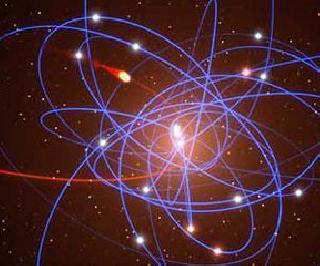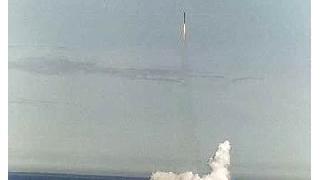
A simulated view of the gas cloud (red orbit) now approaching the supermassive black hole at the center of the Milky Way Galaxy. Photo: ESO
WASHINGTON (PTI): A newly found object hurtling towards the supermassive black hole at the heart of the Milky Way is likely to be consumed by it in about 18 months, predict astronomers.
The expected 2013 rendezvous of the object the size of a small planet, which is rushing towards the black hole at a speed of five million miles an hour, may offer scientists first ever opportunity to witness such an event.
Initially, the object, which was discovered using the European Southern Observatory's Very Large Telescope (VLT) in Chile, was thought to be a gas cloud formed from material from nearby stars.
Now, an analysis from the Harvard-Smithsonian Centre for Astrophysics suggested that the newly found object could have a different origin -- and form a disc of material that would have gone on to form planets, had its parent star not been pulled towards the supermassive black hole.
The scientists think that the star might have been pulled out of a ring of young stars, hinting that many planet-forming discs and even planets could exist in the heart of our galaxy.
"Essentially, we have never seen before how any black hole in the universe is being fed," said study co-author Stefan Gillessen, an astronomer at the Max Planck Institute for Extraterrestrial Physics in Garching, Germany.
"Now we have the chance to watch something fall in," he was quoted as saying by the 'scientificamerican.com'.
The 2013 impact will allow us to determine, whether the object is a gas cloud or a star complete with proto-planetary material, the scientists said.
They believe that the black hole might rip the gas cloud apart and pull it inward, producing a detectable surge in x-ray emissions as the gas compresses and heats up.
Depending on how the cloud breaks up, the black hole may feed on it for years to come, significantly brightening the faint glow that emanates from just outside the edge of the black hole, its event horizon, and providing astrophysicists a unique view of black hole digestion, they reported in the journal Nature.
According to the scientists, the infall that could be observable with large telescopes such as NASA's Chandra X-ray Observatory could give new clues about the environs surrounding the Milky Way's black hole.
It could also provide new information about the behaviour of supermassive black holes, which are found at the centers of all large galaxies, they said.
But the prediction of an infall rests on the conclusion that the object streaking toward a flyby of the Milky Way's central supermassive black hole is indeed a loose blob of gas and not something much sturdier.
Andrea Ghez of the University of California who studies the region surrounding the black hole suspects that the inbound object is in fact a star.
If that were the case, the object would be able to survive such a close passage of the black hole without being torn apart in fact, astronomers have watched stars cruise to within 11 light-hours of the Milky Way's black hole and live to see another orbit.
The black hole, denied its dinner, in that case would continue its steady whisper rather than letting out a roar, they said.
 Previous Article
Previous Article Next Article
Next Article













The Indian Air Force, in its flight trials evaluation report submitted before the Defence Ministry l..
view articleAn insight into the Medium Multi-Role Combat Aircraft competition...
view articleSky enthusiasts can now spot the International Space Station (ISS) commanded by Indian-American astr..
view article